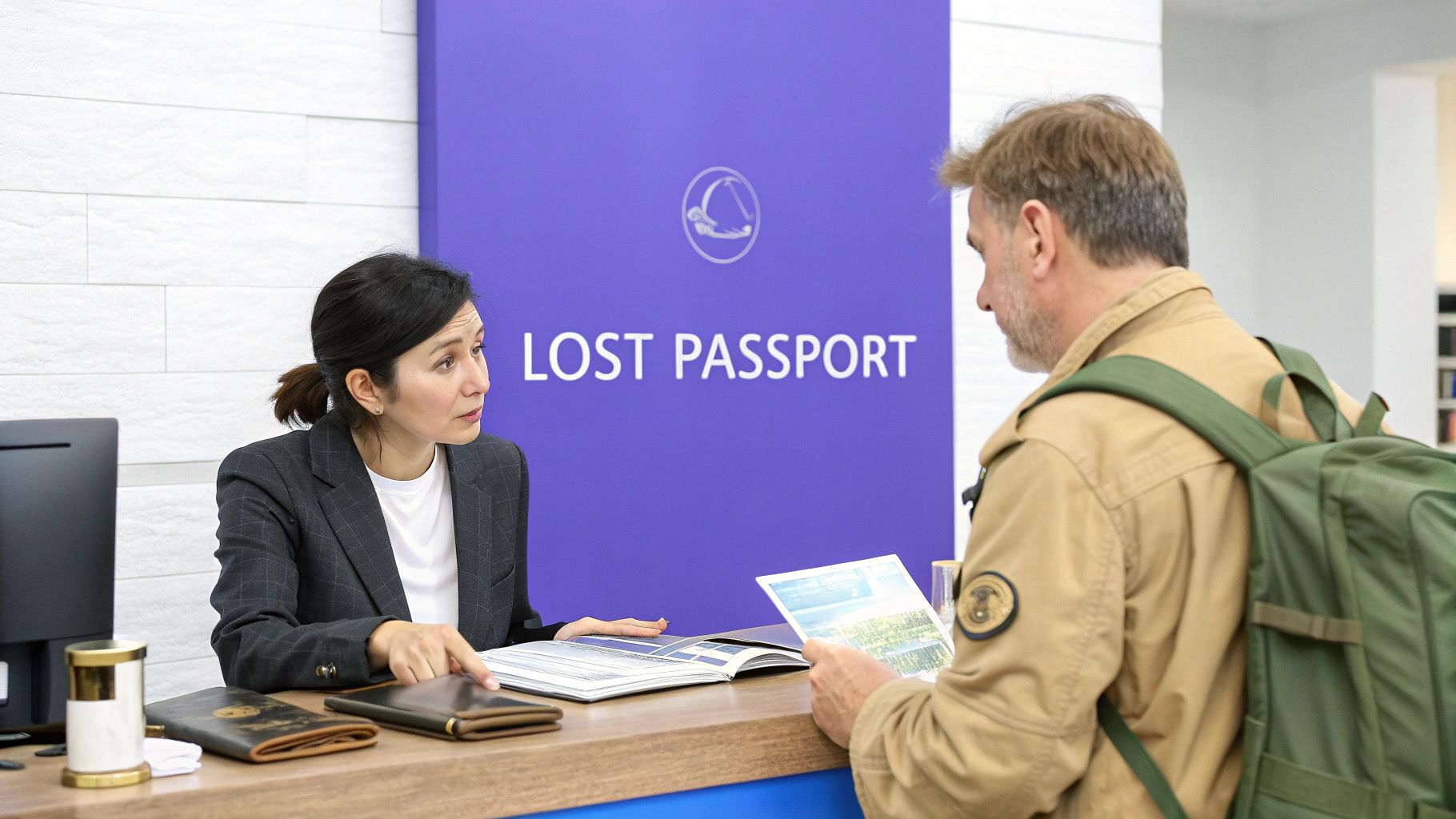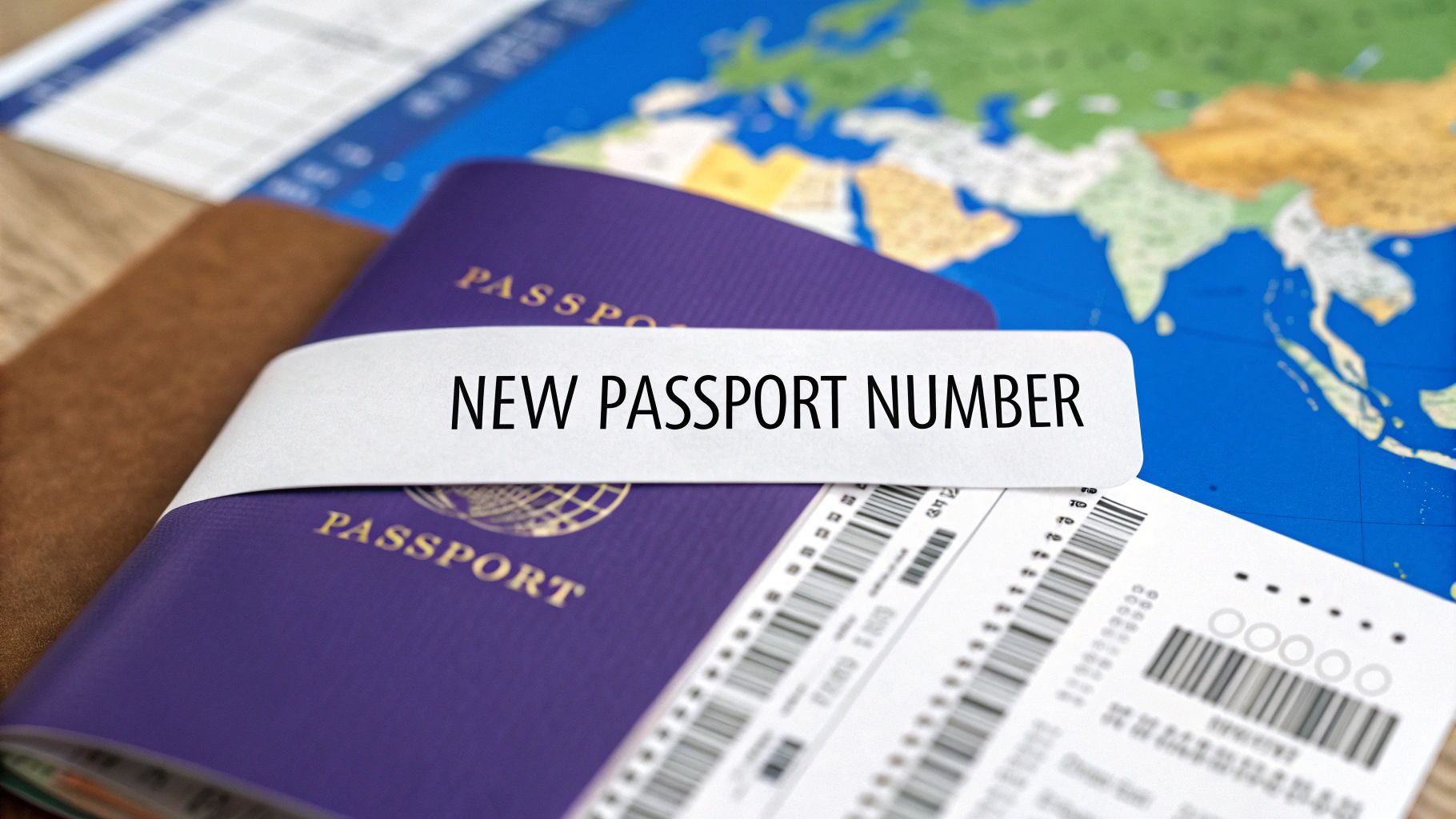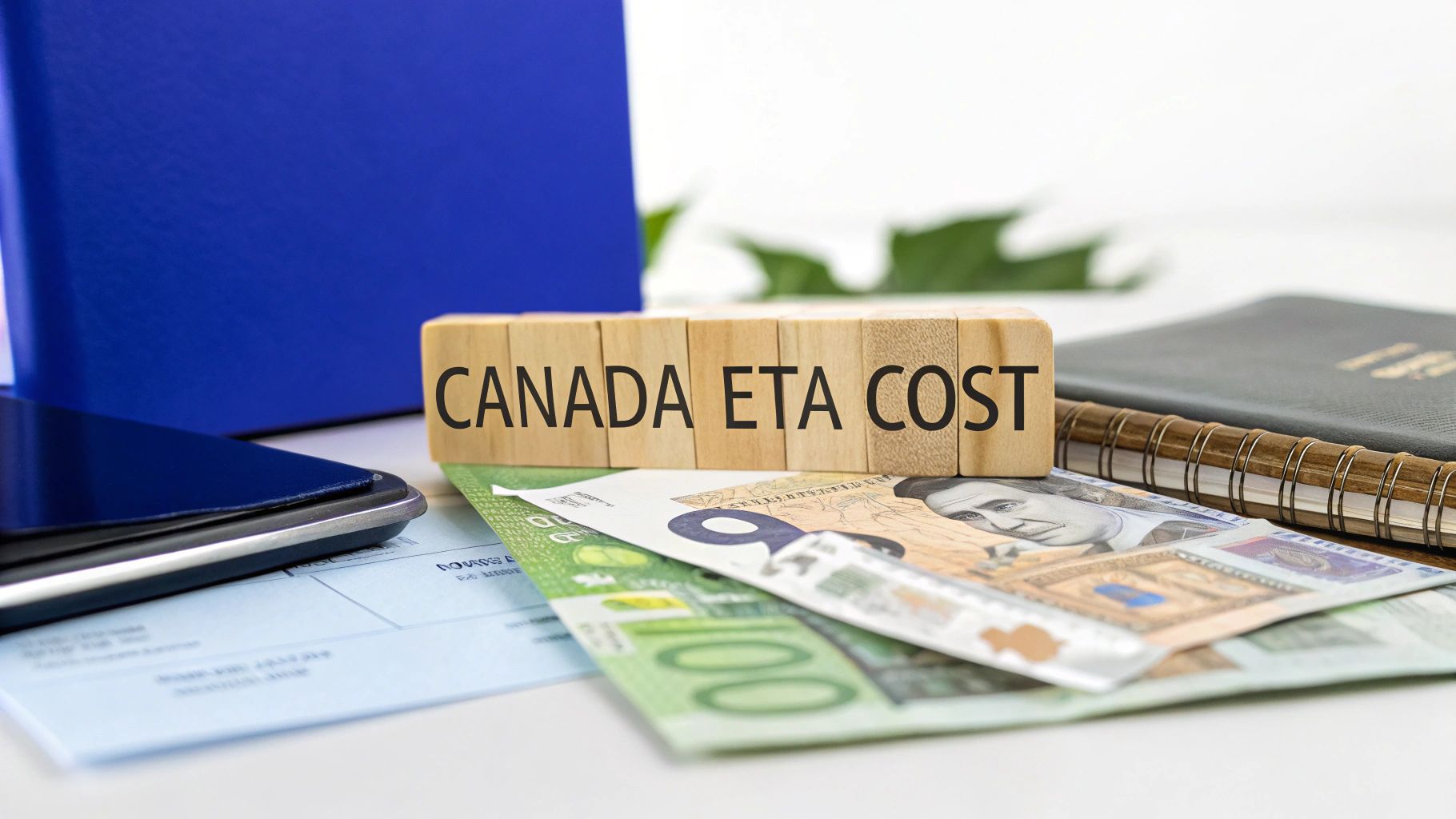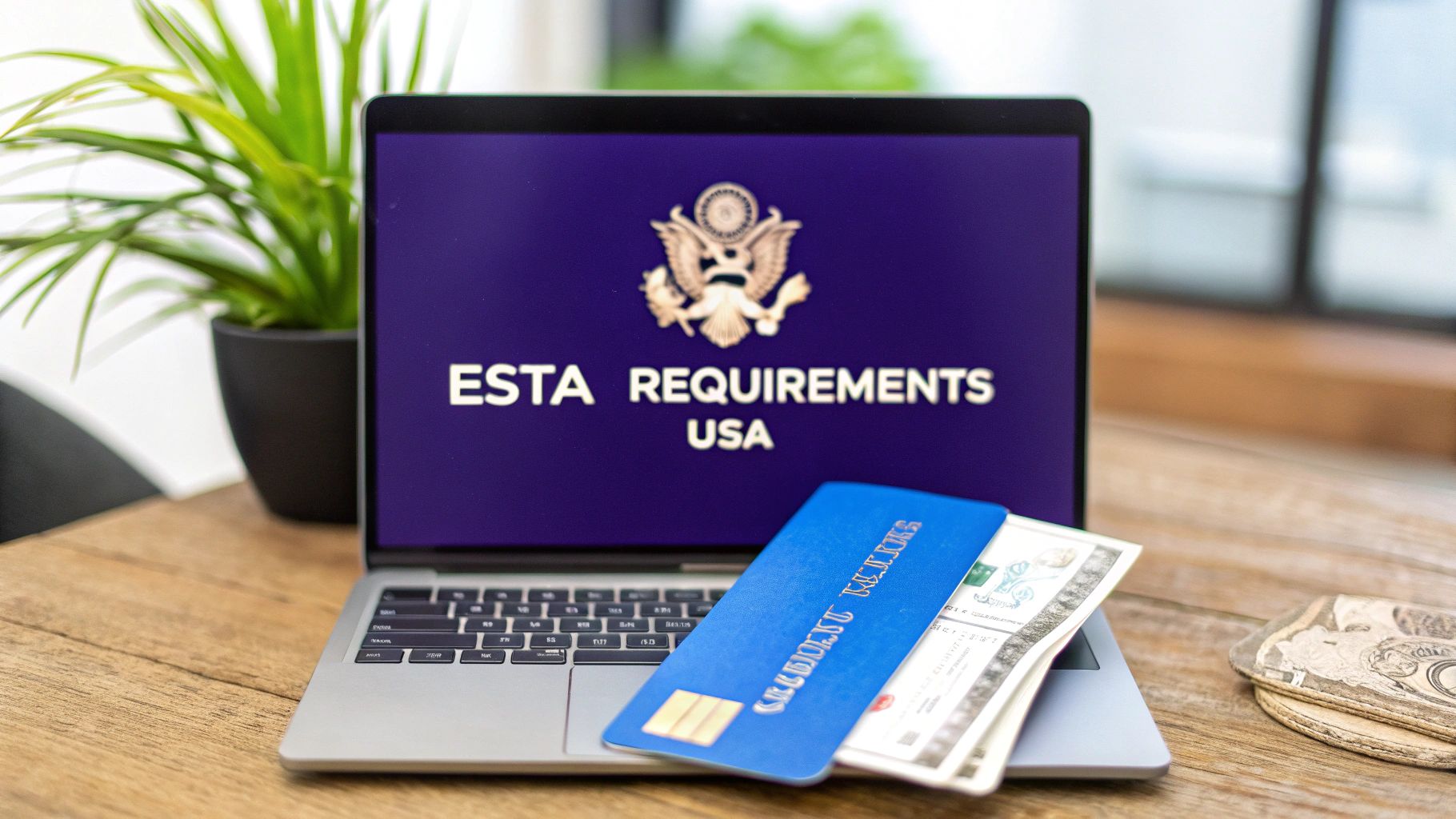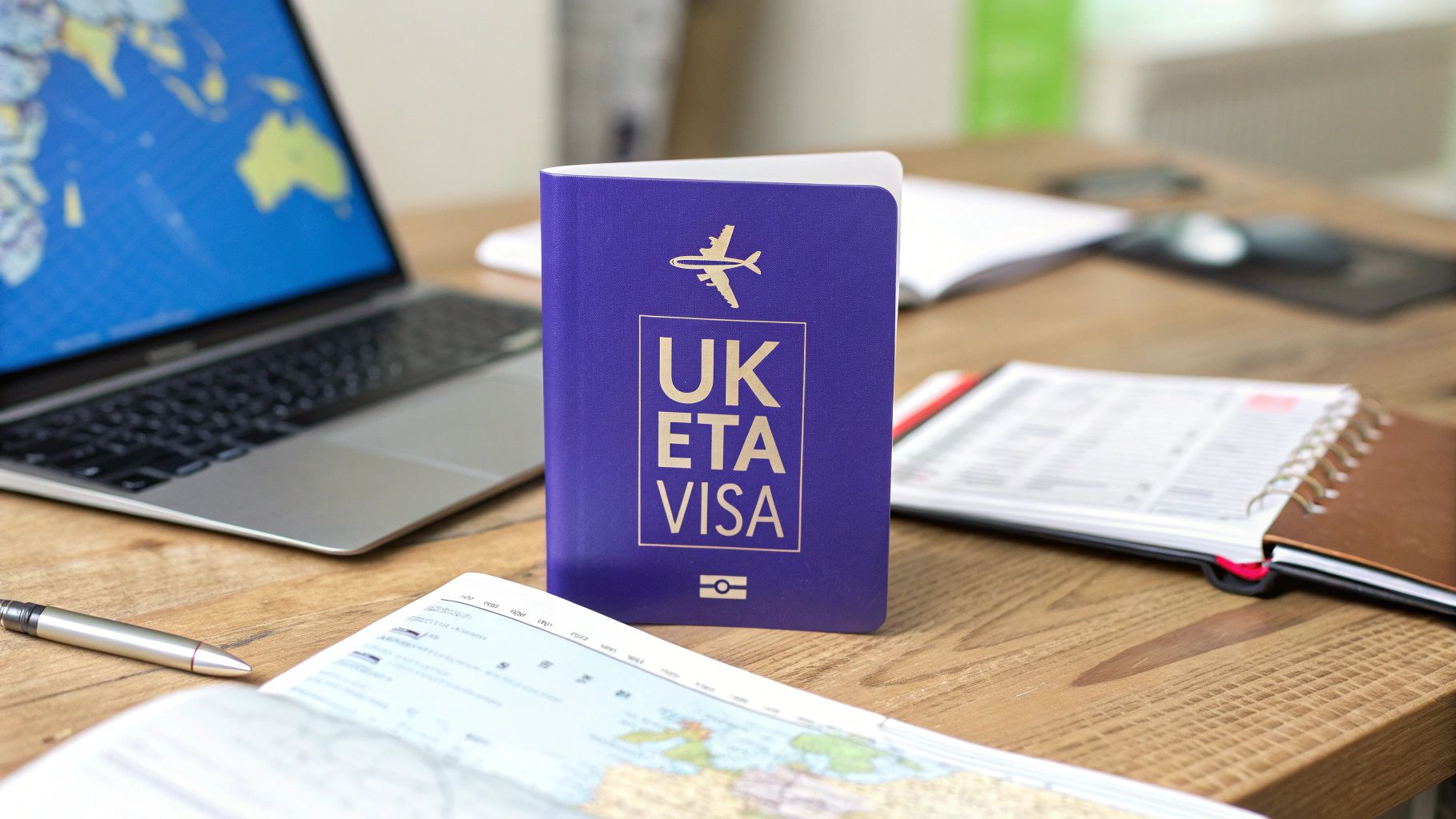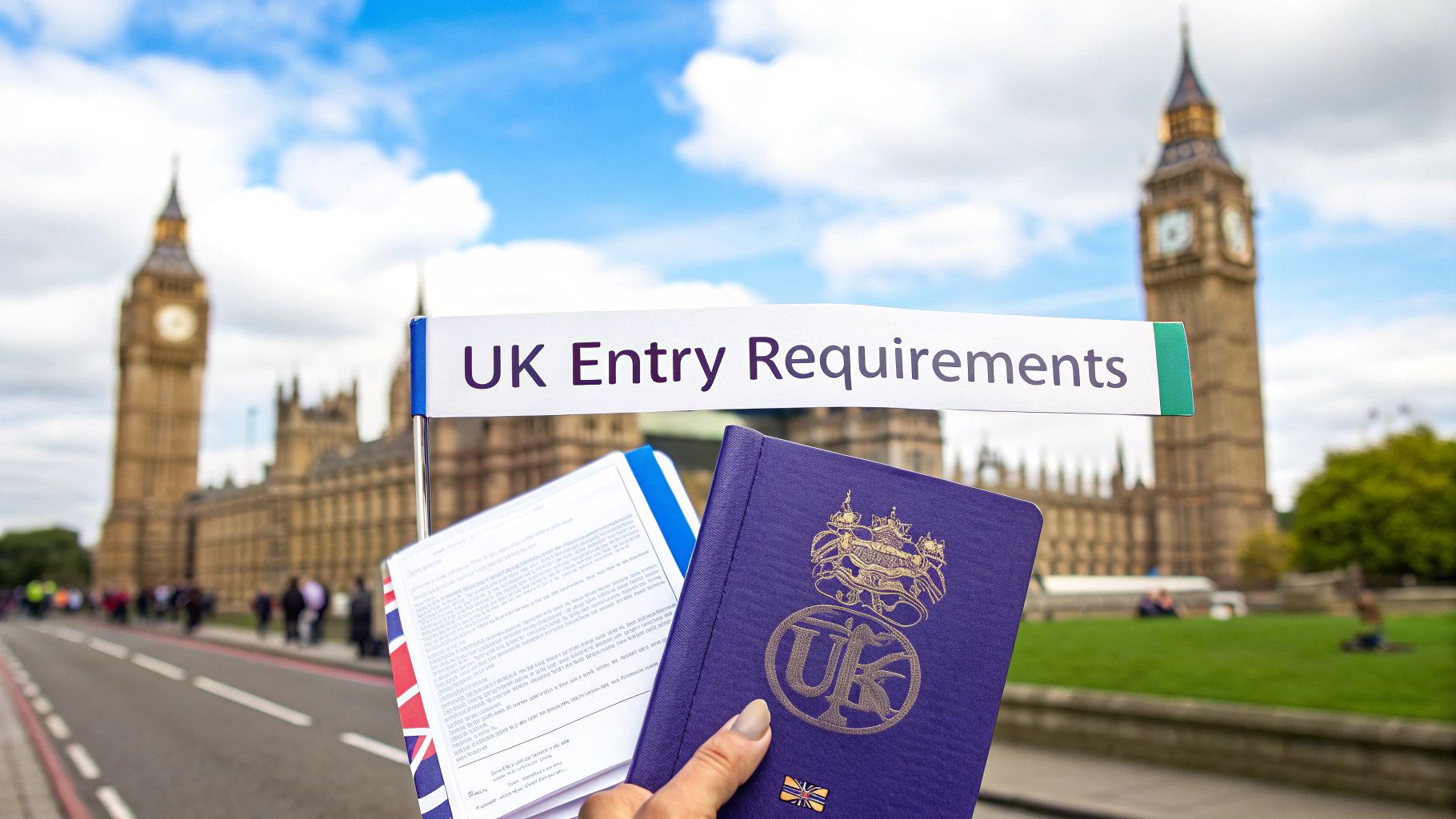
Travel to UK Requirements: Your Complete Guide for a Smooth Trip
Planning your trip to the UK? The first thing to figure out is what kind of entry permission you need, and that all comes down to your nationality. For most tourists from countries like the US, Canada, and Australia, you'll now need an Electronic Travel Authorisation (ETA). For others, a traditional visa is still the way to go.
Your Essential UK Entry Checklist
Figuring out the UK's entry rules can feel a bit overwhelming, but it’s actually pretty straightforward once you know which path you need to take. For most international visitors, there are two main doorways: traveling visa-free (but with a now-mandatory UK ETA) or applying for a visa ahead of time.
Nailing this first step is everything. Get it right, and you're set for a smooth, hassle-free arrival.
Identifying Your Entry Pathway
So, how do you know which path is yours? The first question to ask is whether your country is on the UK's visa-waiver list. If it is, you'll almost certainly need the new Electronic Travel Authorisation for UK.
Think of the ETA as a digital green light. It’s a quick online pre-screening that gives you permission to travel to the UK. While it’s much simpler than a full visa application, it's a critical step you can't skip. The UK government brought this in to speed up border checks and improve security, similar to the systems used in the US (ESTA) and Canada (eTA).
On the other hand, if your country isn't on the visa-waiver list, or if you plan to stay longer than six months, work, or study long-term, you'll need to apply for a formal visa. Knowing this distinction from the get-go will save you a world of trouble down the line.
This infographic gives you a quick visual breakdown of what you'll need.

As you can see, having your passport and the right authorisation sorted is the bedrock of a successful trip.
To make it even clearer, here’s a quick-glance table to help you find your requirement.
UK Entry Requirements At a Glance
Use this table to quickly find your likely entry requirement based on your nationality and travel plans.
| Traveler Profile | Primary Entry Requirement | Common Purpose of Visit |
|---|---|---|
| Citizen of a visa-waiver country (e.g., USA, Canada, Australia, EU) | UK ETA (Electronic Travel Authorisation) | Tourism, business meetings, visiting family, short study (under 6 months) |
| Citizen of a non-visa-waiver country | Standard Visitor Visa or other relevant visa | Tourism, business, family visits, or other specific purposes like work or long-term study |
| Planning to work, study long-term, or live in the UK | Specific Visa (e.g., Skilled Worker, Student) | Employment, higher education, or settlement |
| Irish Citizen | No ETA or visa needed (due to the Common Travel Area) | All purposes |
This table should give you a solid starting point. Always double-check the official UK government website for the most current rules for your specific nationality.
Universal Requirements For All Travelers
No matter if you need an ETA or a visa, a few things are non-negotiable for every single non-British traveler heading to the UK.
You absolutely must have:
- A Valid Passport: Your passport has to be valid for your entire stay. No exceptions.
- Proof of Funds: Be prepared to show you can support yourself financially during your trip. A recent bank statement usually does the trick.
- Travel Itinerary: While not always mandatory to show, it’s a very good idea to have proof of a return flight and your accommodation details handy.
Getting these core documents together is a huge part of your prep. For an even more detailed guide on getting organized, check out our post on https://assistentry.com/blog/how-to-prepare-for-international-travel.
And while you’re thinking about the essentials, practical tips on things like selecting convenient travel bags can make your journey that much smoother. It’s all about making sure every part of your trip, from paperwork to packing, is completely sorted.
Passport Rules and Key Supporting Documents
Think of your passport as the golden ticket for your UK trip—it has to be in perfect shape. Before you even start dreaming about flights or accommodations, your very first step is making sure your passport meets the UK's strict entry rules. This isn’t a friendly suggestion; it’s a hard-and-fast requirement at the border.
The most important rule? Your passport must be valid for your entire stay. If it expires the day before you’re supposed to fly home, you’re in for a world of trouble. UK Border Force officers need to see you have a valid way to leave the country when your visit is over.
An expiring passport can stop your trip in its tracks. To avoid that last-minute scramble, check your expiration date well ahead of time. If you think it might be a close call, our guide on renewing a passport while in the UK has some essential tips.
Beyond the Passport: Your Essential Paperwork
While your passport is the star of the show, it rarely travels alone. Border officials might want to see a few supporting documents to confirm why you're visiting and that you have a solid plan. Having this paperwork ready and organized shows you’re a prepared and genuine visitor.
This supporting cast usually includes:
- Proof of Onward or Return Travel: A confirmed flight ticket showing you have a set date to leave the UK.
- Accommodation Details: Hotel booking confirmations, or even a letter from family or friends if you’re staying with them.
- Evidence of Financial Stability: Recent bank statements or pay stubs to prove you can fund your trip without working or needing public funds.
Basically, you’re building a case for your visit. Each document helps paint a clear picture for the border officer: you're a tourist with a plan, the funds to back it up, and a clear intention to return home.
Real-World Examples of Supporting Documents
Let's make this more concrete. Say you're visiting for a two-week holiday. You might bring a small folder with:
- A printout of your return flight confirmation email.
- The reservation confirmation for your hotel in London.
- A digital or printed copy of your last two months' bank statements.
This level of prep work can make your arrival quick and painless. Honestly, many travelers are never even asked for these documents, but having them on hand gives you invaluable peace of mind.
The UK’s Standard Visitor Visa is a major pathway for tourism, with over 2 million applications processed each year and an approval rate of 77% for those who qualify. The new Electronic Travel Authorisation (ETA) system for most non-visa nationals is updating these rules, bringing the UK in line with digital systems in other countries. You can find more insights on UK visa statistics on connaughtlaw.com.
At the end of the day, a valid passport and an organized set of supporting documents are the foundation of a great trip. Get these right, and you'll be starting your UK adventure without a single hitch.
Understanding the New UK ETA System
One of the biggest shifts in UK travel rules lately is the rollout of the Electronic Travel Authorisation (ETA). If you’ve ever traveled to the United States or Canada, the idea of a digital travel pass like the ESTA or eTA will feel familiar. The UK ETA works in a similar way—it's a digital green light for your trip.
Think of it as a mandatory permission slip you need before you fly. For travelers from countries like the United States, Canada, Australia, and the EU who never needed a visa for short trips, this is a brand new step. You can't just show up with your passport anymore; getting an ETA is now a crucial part of your prep.
The whole point is to pre-screen visitors before they land. By gathering a little bit of information ahead of time, the UK government can speed up the entry process for legitimate tourists while flagging potential security concerns.
Who Needs to Apply for a UK ETA?
The UK is introducing the ETA requirement in stages, but soon it will be mandatory for most travelers who previously enjoyed visa-free entry for short visits.
This applies to you if you're traveling for:
- Tourism: Sightseeing, holidays, and exploring.
- Visiting Family and Friends: Quick trips to see loved ones.
- Business: Attending conferences, meetings, or contract talks.
- Short-Term Study: Any course that lasts less than six months.
- Transit: Even if you’re just changing planes at a UK airport, an ETA might be required.
It’s incredibly important to check the official requirements for your nationality before you book anything. The rules are new and can be updated, and ignorance won't be a valid excuse at the border. We break down the key differences in our guide comparing UK visa vs ETA requirements.
The UK ETA Application Process Step-by-Step
Getting a UK ETA is done entirely online. You’ll need to provide your personal details, passport information, a digital photo, and answer a few standard security questions. The official process is designed to be simple, but it's also unforgiving—a tiny mistake can cause a delay or even a flat-out rejection.
This is where a third-party application assistance provider like AssistEntry becomes a traveler's best friend. Their experts act as your co-pilot, making sure every part of your UK ETA application is perfect before it goes to the UK authorities.
The screenshot below shows just how simple and clear their starting point is.

This straightforward interface takes all the guesswork out of the process, guiding you from start to finish.
Why Use an Expert Application Service?
Sure, you can apply directly through the government's website. But with any new system, there are pitfalls. A simple typo in your passport number, a photo that isn't formatted just right, or a misunderstood question can get your application flagged for a manual review—or worse, denied. That means stress, delays, and potential disruption to your travel plans.
Using a service like AssistEntry is all about avoiding that headache. Their specialists add a critical layer of review to catch those common errors.
For a fee that starts from just $79 (it include government fee, all cost included), their service gives you complete peace of mind. They meticulously check every detail for errors and compliance, which massively boosts your chances of getting approved on the first try.
Here’s what that looks like in practice:
- Full Application Verification: An expert reviews every single field for accuracy.
- Error-Checking and Compliance: They spot and fix the common mistakes that trip people up.
- Increased Approval Odds: A professionally reviewed application is far less likely to run into problems due to expert handling.
By letting them handle the nitty-gritty, you can skip the stress and focus on what really matters—planning the exciting parts of your trip. It's a small price to pay for a much smoother journey.
When Do You Need a UK Visitor Visa?
While the new UK ETA system is making travel easier for millions, it's not a universal pass. Knowing when to switch from the straightforward ETA application to the more involved Standard Visitor Visa process is one of the most important steps in planning your trip.
Getting this wrong is a classic mistake. It can lead to a lot of stress and, in the worst-case scenario, being turned away at the border.
Think of the ETA as a quick digital green light for simple tourism or business trips under six months. A visa, on the other hand, is a much more formal and detailed permit required for specific situations. They’re two different tools for two different jobs.
Scenarios Requiring a Standard Visitor Visa
So, when do you need to skip the ETA and apply for a full visa? It usually boils down to a few key factors. If any of the following describe your travel plans, you’ll need to go through the Standard Visitor Visa application process.
You will almost certainly need a UK Visitor Visa if:
- Your nationality requires it. Not every country is part of the UK’s visa-waiver program. If you’re from a country that isn't on the ETA-eligible list, you'll need a visa, no matter how short your trip is.
- You plan to stay longer than six months. The ETA is strictly for short-term visits. Anything beyond that six-month mark automatically puts you in visa territory.
- Your purpose isn't covered by the ETA. If you plan to do things like get married, take a long-term study course, or perform paid work, a Standard Visitor Visa (or another specific type of visa) is required.
- You've been refused entry to the UK before. A previous immigration refusal can disqualify you from using the simpler ETA system, making a formal visa application your only path forward.
Comparing the Application Processes
The difference between applying for an ETA and a visa is like the difference between filling out a quick online form and preparing for a detailed interview.
The UK ETA application is designed to be fast and simple. You'll provide basic personal and passport details, answer a few security questions, and you’re usually done.
A visa application, however, is a much deeper dive. You’ll need to gather extensive documents, which could include bank statements, proof of employment or property ownership back home, and a clear travel itinerary. You'll likely also need to attend an appointment at a visa application centre to give your fingerprints and have a photo taken.
The UK manages a mind-boggling number of arrivals. Official stats from the Home Office show a staggering 134.8 million people crossed UK borders in a single year. While the new ETA handles millions of visa-exempt travelers, a significant 2.2 million visitors still come through the formal visitor visa route each year. You can discover more insights about these UK immigration statistics on workpermitcloud.co.uk.
This huge scale is exactly why both systems exist. They’re designed to handle different levels of scrutiny based on a traveler’s nationality and what they plan to do in the UK.
For those who need to navigate the more complex visa route, understanding every requirement is key. We break it all down in our complete guide to the UK visitor visa application to help you get prepared. Picking the right path from the start is the best way to ensure your journey begins smoothly.
Navigating UK Customs and Border Control
You’ve made it. After months of planning, your flight has finally touched down in the United Kingdom. Now for the final step: clearing the border. This part can feel a bit intimidating, but a little preparation makes it a quick, straightforward process before your UK adventure officially begins.

Whether this is your first trip or your fiftieth, being organized is everything. Have your passport, boarding pass, and any other key documents ready to go. It signals to Border Force officers that you’re a genuine visitor and helps set a positive, efficient tone for your arrival.
At the UK Border: eGates vs. Officer Desks
When you arrive, you'll be directed into one of two lanes for immigration control. Which one you use depends on your passport and nationality.
eGates (Automated Border Control): These are the fast track. If you're a citizen of the UK, EU, USA, Canada, Australia, New Zealand, Japan, Singapore, or South Korea and have a biometric passport (the one with the little camera symbol on the cover), you can use the automated eGates. Just scan your passport, look into the camera, and the gates swing open.
Border Force Officer: If you aren't eligible for the eGates or you're traveling with children under 10, you'll speak with a Border Force officer. This is a totally normal procedure. The officer will check your documents, ask a few questions, and stamp your passport if needed.
Answering Questions from Border Force
Don't be nervous if you're directed to an officer. They are just doing their job to confirm that all travel to UK requirements are met. The key is to be clear, confident, and honest.
Expect simple questions like, "What is the purpose of your visit?" or "How long do you plan to stay?" Having your travel plans and hotel details handy will help you answer accurately and keep things moving.
This quick chat is just to make sure your intentions match your entry clearance, whether that’s a visa or an ETA. A calm, straightforward approach is always the best way to go.
Declaring Goods: What You Need to Know
Once you’re through immigration, you’ll grab your bags and head to customs. This is where you have to declare certain goods you're bringing into the country. The UK has strict rules to protect its economy and environment, so it pays to know what they are.
You have to declare anything over your duty-free allowance and any items that are restricted or banned. The main things to watch out for are:
- Alcohol and Tobacco: The limits are specific. For example, you can bring in 42 litres of beer and 18 litres of still wine, but the allowance for spirits is much smaller.
- Food and Plant Products: Be very careful here. There are strict rules on bringing in meat, dairy, potatoes, and certain plants to prevent the spread of diseases. It's always best to check the latest guidance on the official UK government website before you pack any food.
- Cash: If you're carrying £10,000 or more (or the equivalent in another currency), you must declare it.
Failing to declare items can lead to them being seized, and you could even face a fine. If you’re not sure about something, just go through the "goods to declare" channel and ask an officer. A moment of honesty is far better than starting your trip with a problem.
Simplify Your UK Travel with Expert Help
Navigating the web of travel to UK requirements can feel like you're trying to solve a high-stakes puzzle, especially with new systems like the Electronic Travel Authorisation (ETA). While the official application process is designed to be user-friendly, one simple typo or a misunderstood question can lead to frustrating delays—or even an outright denial. That puts your entire trip on the line.
This is exactly why so many travelers are choosing to work with a third-party application assistance provider. Instead of crossing your fingers and hoping for the best, you can have an expert meticulously check every single detail of your UK ETA application before it ever gets submitted.
Why Expert Review Matters
Think of it like having a seasoned editor proofread an important document before you send it off. A fresh pair of expert eyes can easily spot the kind of common mistakes you might overlook, making sure your application is perfectly compliant and error-free. This dramatically boosts your chances of getting a swift, first-time approval.
AssistEntry specializes in providing this critical final check. For a single fee that starts from just $79 (which includes the government fee), their team of experts provides:
- Full Verification: Every piece of information on your application is double-checked for accuracy and consistency against your documents.
- Error-Checking and Compliance: They review your submission against the latest official guidelines to catch common errors that often trigger rejections.
- Increased Approval Chances: A professionally reviewed application is far less likely to run into issues, giving you genuine peace of mind.
To simplify your ETA application and increase your chances of approval, consider using AssistEntry — their experts guide you through the entire process, starting from just $79.
The Bigger Picture of UK Entry
Recent changes to UK work and family visas have definitely shifted the immigration landscape, but the Standard Visitor route remains the main pathway for tourism. With a visa approval rate of 77%, the UK's visitor system is one of the more accessible in the world.
That said, the rollout of the ETA for non-visa nationals signals a clear shift toward digital border management. It's a trend we're seeing globally. You can dive deeper into these trends by reviewing the official UK government visa application statistics.
Ultimately, whether you're applying for an ETA or a full visa, the goal is a smooth, stress-free journey. And that preparation goes beyond just paperwork. Practical advice, like a few tips for staying fresh and comfortable while traveling, can make a world of difference on a long-haul flight. By preparing for everything—from your digital application to your in-flight comfort—you're setting yourself up for an incredible UK adventure.
Common Questions About UK Travel Requirements
Figuring out the rules for entering the UK can feel a bit confusing, especially with new systems like the Electronic Travel Authorisation (ETA) coming into play. Getting straight answers is the best way to feel confident and ready for your trip.
We've pulled together some of the most common questions travelers have about the key travel to UK requirements to help you avoid any last-minute surprises.
What Is the Difference Between a UK ETA and a Visa?
Think of it this way: a UK ETA is like a digital hall pass, while a visa is a full-blown permission slip.
The UK ETA is a simple, electronic pre-approval for travelers from visa-exempt countries (like the USA, Canada, and Australia) who are just visiting for a short time—think tourism, a quick business trip, or visiting family. It's not a visa; it's a lighter form of pre-screening.
A visa, on the other hand, is a much more formal and detailed document. You'll need one if you're from a country that requires a visa for UK entry, or if you plan to stay longer than six months, work, or study long-term. The visa process is far more involved and usually requires a pile of paperwork and an in-person appointment.
How Far in Advance Should I Apply for My UK ETA?
Timing is everything. While most UK ETA applications are approved in a few hours, the official advice is to allow up to three working days.
To be on the safe side, we strongly recommend applying at least 72 hours before you’re due to fly. Honestly, the best approach is to get it done a few weeks in advance. That way, you have a nice buffer to sort out any unexpected hiccups without putting your trip at risk.
Can My UK ETA Application Be Denied?
Yes, an ETA application can be denied. It can happen for all sorts of reasons, from a simple typo in your passport number to more serious issues with your immigration history.
Even a tiny mistake can get your application flagged for review or outright rejected. This is exactly why so many travelers choose to have an expert look it over first.
Using a trusted third-party application assistance provider drastically cuts down the risk of denial from simple, avoidable errors. An expert check makes sure your application is perfect before it's sent off to the authorities.
What Happens If I Arrive Without a Required ETA or Visa?
This is a scenario you absolutely want to avoid. In almost every case, your airline will check for your ETA or visa before you even get on the plane. If you don't have it, you'll be denied boarding. Your trip will be over before it even starts.
If you somehow managed to get on the flight, UK Border Force would refuse you entry the second you landed. Getting the right travel permission isn't just a suggestion—it's a non-negotiable requirement for getting into the country.
Trying to handle the UK ETA application yourself can be a headache, where one small mistake could lead to delays or a denial. To make sure your application is smooth and error-free, let the experts at AssistEntry take care of it for you. Their team checks every detail, and their service starts at just $79, which includes all government fees.
Apply with confidence by visiting AssistEntry’s UK ETA page today.
